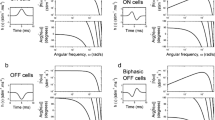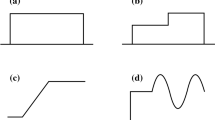Summary
Firstly two possible principles for the coding of messages into sequences of nerve spikes — the pulse-count-modulation and the pulse-interval-modulation — are compared; for several reasons the pulse-interval-modulation was choosen as the convenient basis for the following calculations. The information rates of afferent nerve fibers are calculated by means of data concerning the statistical properties of the spike-sequences evoced by stimulation; this data were found in the literature as well as in some own experiments. The non-linear relationship of input-signals (i.e. stimulus strength) and output-signals (mean-spike-interval = reciprocal of the firing rate) has no effect on the information rate; the influences of the channel transfer function and of the probability distribution of the input signals (the channel capacity accounts to the optimal distribution) are studied. Finally, numerical results for some kinds of afferent channels are presented; the importance of such calculations is discussed.
Similar content being viewed by others
Literatur
Appel, U.: Der Einsatz der nichtlinearen Programmierung zur Bestimmung der Kanalkapazität von signal-wertbegrenzten Analogkanälen. Diplomarbeit 1967 am Institut für Nachrichtentechnik der Technischen Hochschule München.
Barlow, H. B.: Possible principles underlying the transformation of sensory messages. Sensory communication, ed. Rosenblith, (1961).
Barlow, H. B.: The information capacity of nervous transmission. Kybernetik 2, 1 (1963).
Biscoe, T. J., and A. Taylor: The discharge pattern recorded in chemoreceptive afferent fibers from the cats carotid body with normal circulation and during perfusion. J. Physiol (Lond.) 168, 332 (1963).
Bishop, O. P., R. Levick, and W. O. Williams: Statistical analysis of the dark discharge of lateral geniculate neurones. J. Physiol. (Lond.) 170, 598 (1964).
Buller, A. J., J. G. Nicholls, and G. Ström: Spontaneous fluctuations of excitability in the muscle spindle of the frog. J. Physiol. (Lond.) 122, 409 (1953).
Färber, G.: Der Transinformationsfluß einer einzelnen Nervenzelle. In: Fortschritte der Kybernetik, S. 157. München: Oldenbourg (1967).
Färber, G.: Berechnung und Messung des Informationsflusses der Nervenfaser. Diss. an der Fakultät für Maschinenwesen und Elektrotechnik der Technischen Hochschule München, (1967).
Färber, G.: Die Kanalkapazität allgemeiner Übertragungskanäle bei begrenztem Signalwertbereich, beliebigen Signalübertragungszeiten sowie beliebiger Störung. AEÜ 21, H. 11/12 (1967).
Fetz, E., and G. L. Gerstein: R-C-modells for the spike activity of a single neuron. MIT-Report Nr 71 (1963).
Fitzhugh, R.: The statistical detection of treshold signals in the retina. J. gen. Physiol. 40, 925 (1956).
Gerstein, G. L., and N. Y. Kiang: Responses of single units in the auditory cortex. Exp. Neurol. 10, 1 (1964).
Gerstein, G. L., and N. Y. Kiang: An approach to the quantitative analysis of electrophysiological data from single neurons. Biophys. J. 1, 15 (1960).
Gerstein, G. L., and B. Mandelbrot: Random walk models for the spike activity of a single neuron. Biophys. J. 4, 42 (1964).
Gestri, G., L. Maffei, and D. Petracchi: Spatial and temporal organisation in retinal units. Kybernetik 3, 196 (1966).
Grüsser, O.-J., K. A. Hellner u. U. Grüsser-Cornehls: Die Informationsübertragung im afferenten visuellen System. Kybernetik 1, 175 (1962).
Grüsser, O.-J.: Die Informationskapazität einzelner Nervenzellen für die Signalübermittlung im Zentralnervensystem. Kybernetik l, 209 (1962).
Henze, E.: Einführung in die Informationstheorie. Beiheft 3 der Elektron. Rechenanlagen. München: Oldenbourg (1963).
Herz, A., O. Creutzfeldt u. J. Fuster: Statistische Eigenschaften der Neuronaktivität im ascendierenden visuellen System. Kybernetik 2, 61 (1964).
Herz, A., u. G. Färber: Statistische Auswertung der unter verschiedenen physiologischen und pharmakologischen Bedingungen abgeleiteten Reaktionspotentiale. Arzneimittel-Forsch. 16, 299 (1966).
Ten Hoopen, M., A. Den Hertog, and H. A. Reuver: Fluctuations in excitability of nerve fibers. Kybernetik 2, 1 (1963).
Junge, D., and G. P. Moore: Interspike-intervall fluctuations in Aplysia Pacemaker neurons. Biophys. J. 6, 411 (1966).
MacKay, D. M., and W. S. McCulloch: The limiting information capacity of a neuronal link. Bull. Math. Biophys. 14, 127 (1952).
Kiang, N. Y., and W. T. Peake: Components of electrical responses recorded from the cochlea. Ann. Otol. (St. Louis) 69, 1 (1960).
Kiang, N. Y., T. Watanabe, E. C. Thomas, and L. F. Clark: Stimulus coding in the cats auditory nerve. Ann. Otol. (St. Louis) 71, 1009 (1962).
Kiang, N. Y., and M. H. Goldstein: Temporal coding of neural responses to acoustic stimuli. IEEE-Trans. Inform. Theory IT-8, 114 (1962).
Kuffler, S. W., R. Fitzhugh, and H. B. Barlow: Maintained activity in the cats retina in light and darkness. J. gen. Physiol. 40, 683 (1963).
Lotze, A.: Einführung in die Informationstheorie. NTZ 16, 473 (1963).
Marko, H.: Die Ausnutzbarkeit eines Telegraphiekanals zur Informationsübertragung. Nachrichtentechn. Z. 15, 451–466 (1962).
Marko, H.: Die Kanalkapazität des Telegraphiekanals und verwandter Übertragungskanäle. Nachrichtentechn. Z. 16, 480–485 (1963).
Marko, H.: Physikalische und biologische Grenzen der Informationsübermittlung. Kybernetik 3, 274 (1963).
Mountcastle, V. B., G. F. Poggio, and G. Werner: The relation of thalamic cell response to periphal stimuli variied over an intensive continuum. J. Neurophysiol. 26, 807 (1963).
Neidhardt, P.: Die Anwendung der Informationstheorie beim Studium der neuronalen und humoralen Informationsverarbeitung. Nachrichtentechnik 13, 50 (1964).
Piloty, H.: Die Grundbegriffe der Informationstheorie. NTZ 17, 123 (1964).
Poggio, G. F., and V. B. Mountcastle: The functional properties of ventrobasal thalamic neurons studied in unanesthetized monkeys. J. Neurophysiol. 26, 775 (1963).
Ratliff, F.: Vortrag auf dem Vision-Symposium des Max-Planck-Instituts für Biologie, Abteilung Reichardt, sowie mündliche Mitteilung (1966).
Segundo, J. P., D. H. Perckel, and G. P. Moore: Spike probability in neurons: Influence of temporal structure in the train of synaptic events. Kybernetik 3, 67 (1966).
Siebert, W. M.: Some implications of the stochastic behavior of primary auditory neurons. Kybernetik 2, 206 (1965).
Shannon, C. E.: A mathematical theory of communication. Bell Syst. techn. J. 27 (1948).
Straschill, M.: Aktivität von Neuronen im Tractus Opticus und Corpus Geniculatum Laterale bei langdauernden Lichtreizen verschiedener Intensität. Kybernetik 3, 1 (1966).
Straschill, M.: Neuronale Reaktion im Tectum Opticum der Katze auf bewegte und stationäre Lichtreize. Exp. Brain Res. (1967, im Druck).
Theodoritis, Negrete, Guillerma, Yankelevich, and Stark: MIT Report, Neurology (1964).
Verveen, A. A., and H. E. Derksen: Fluctuations in membrane potentials of axons and the problem of coding. Kybernetik 2, 152 (1965).
Viernstein, L. J., and R. G. Grossmann: Neural discharge patterns in the transmission of sensory information. In: Fourth London Symp. on Inf. Theory (C. Cherry, ed.), (1961).
Weiss, T. F.: A model of the peripheral auditory system. Kybernetik 3, 154 (1966).
Werner, G., and V. B. Mountcastle: The variability of central neural activity in a sensory system, and its implications for the central reflection of sensory events. J. Neurophysiol. 26, 958 (1963).
Werner, G., and V. B. Mountcastle: Neural activity in mechanoreceptive cutaneous afferents: Stimulus response relations, Weber functions, and information transmission. J. Neurophysiol. 28, 359 (1965).
Author information
Authors and Affiliations
Additional information
Auszug aus einer von der Fakultät für Maschinenwesen und Elektrotechnik der Technischen Hochschule München genehmigten Dissertation.
Rights and permissions
About this article
Cite this article
Färber, G. Berechnung und Messung des Informationsflusses der Nervenfaser. Kybernetik 5, 17–29 (1968). https://doi.org/10.1007/BF00288895
Received:
Issue Date:
DOI: https://doi.org/10.1007/BF00288895




